Blank L., Tarquin A. Engineering Economy (McGraw-Hill Series in Industrial Engineering and Management)
Подождите немного. Документ загружается.

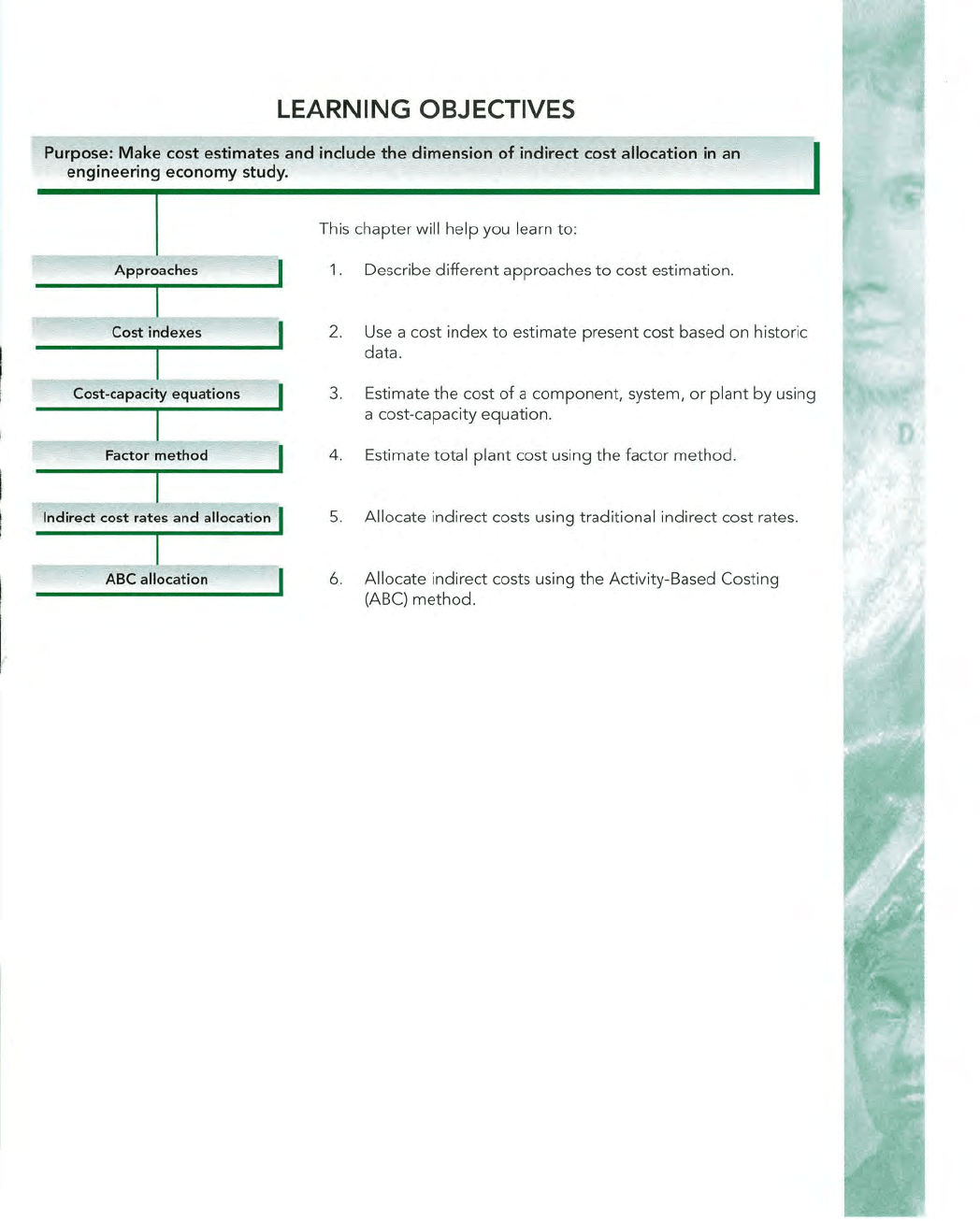
LEARNING OBJECTIVES
Purpose:
Make
cost estimates and include
the
dimension
of
indirect cost allocation
in
an
engineering economy study.
Approaches
Cost indexes
Cost-capacity equations
Factor
method
Indirect cost rates and allocation
ABC allocation
This
chapter
will
help you learn
to
:
1.
Describe different
approaches
to
cost
estimation.
2. Use a
cost
index
to
estimate
present
cost
based
on
historic
data.
3.
Estimate
the
cost
of
a
component,
system,
or
plant
by using
a cost-capacity
equation
.
4. Estimate
total plant
cost
using
the
factor
method.
5. Allocate indirect
costs
using traditional indirect
cost
rates.
6.
Allocate indirect
costs
using
the
Activity-Based
Costing
(ABC)
method
.
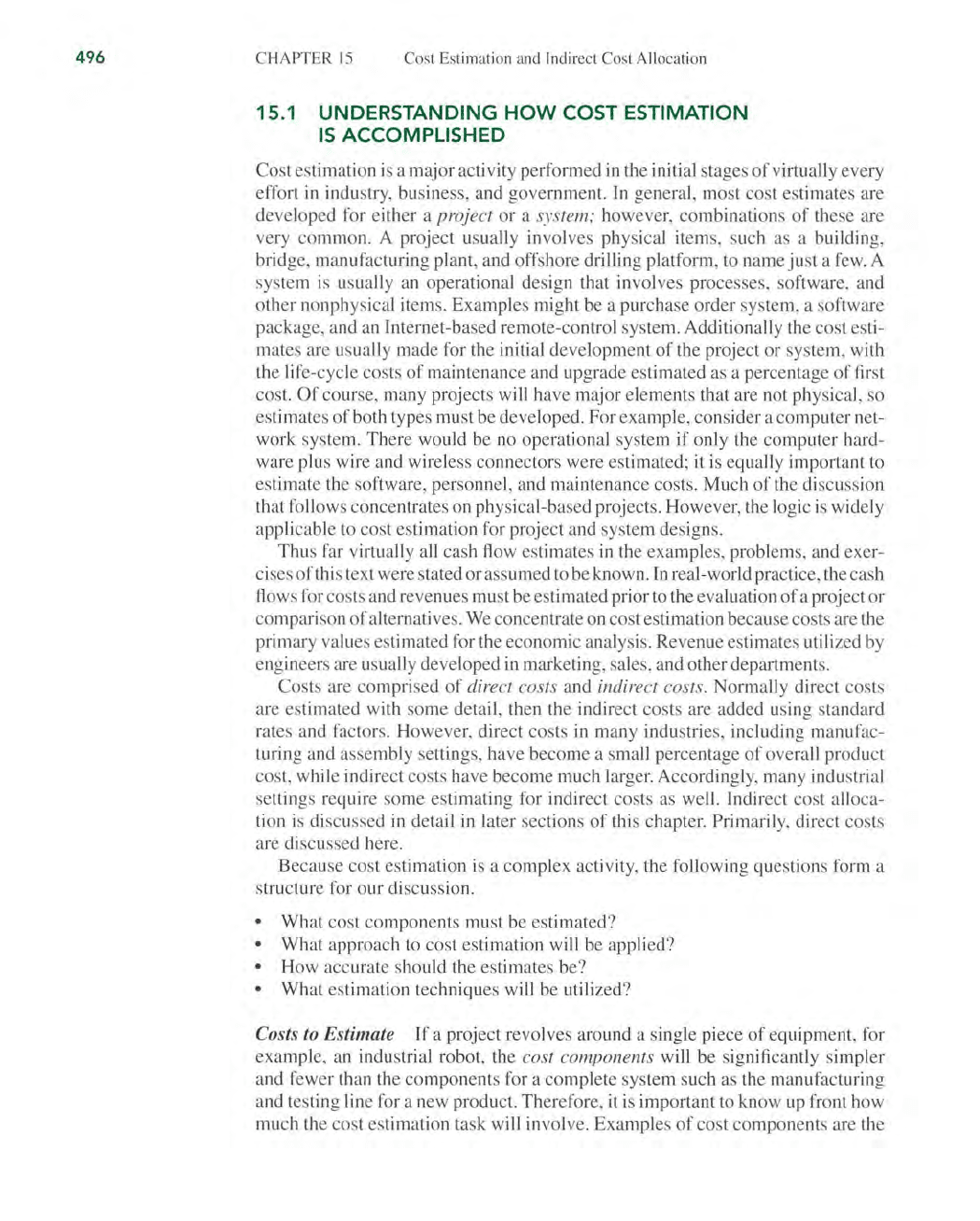
496
CHAPTER
15
Cost
Estimation and Indirect
Cost
Allocation
15.1 UNDERSTANDING
HOW
COST ESTIMATION
IS
ACCOMPLISHED
Cost estimation
is
a major activity performed
in
the initial stages
of
virtually every
effort
in
industry, business, and government.
In
general, most cost estimates are
developed for eith
er
a project
or
a system; however, combinations
of
these are
very common. A project usually involves physical items, such as a building,
bridge, manufacturing plant, and offshore drilling platform, to name
just
a few. A
system
is
usually an operational design that involves processes, software, and
other nonphysical items. Examples might be a purchase order system, a software
package, and an Internet-based remote-control system. Additionally the cost esti-
mates are usually made for the initial development
of
the project
or
system, with
the life-cycle costs
of
maintenance and upgrade estimated as a percentage
of
first
cost.
Of
course, many projects will have major elements that are not physical, so
esti mates
of
both types
must
be
developed.
For
example, consider a computer net-
work system.
There
would be no operational system
if
only the computer hard-
ware plus wire and wireless connectors were estimated; it is equally important to
estimate the software, personnel, and maintenance costs.
Much
of
the discussion
that follows concentrates on physical-based projects. However, the logic
is
widely
applicable to cost estimation for project and system designs.
Thus far virtually all cash flow estimates
in
the examples, problems, and exer-
cises
of
this text were stated
or
assumed to
beknown.
In
real-world practice, the cash
flows for costs and revenues must be estimated prior to the evaluation
of
a project
or
comparison
of
alternatives. We concentrate on cost estimation because costs are the
primary values estimated for the economic analysis. Revenue estimates utilized by
eng
in
eers are usually developed in marketing, sales, and other departments.
Costs are comprised
of
direct costs and indirect costs. Normally direct costs
are estimated with some detail, then the indirect costs are added using standard
rates and factors. However, direct costs in many industries, including manufac-
turing and assembly settings, have
become
a small percentage
of
overall product
cost, while indirect costs have become much larger. Accordingly, many industrial
settings require
some
estimating for indirect costs as well. Indirect cost alloca-
tion
is
discussed
in
detail in later sections
of
this chapter. Primarily, direct costs
are discussed here.
Because cost estimation is a complex activity, the following questions form a
structure for
our
discussion.
•
•
•
What cost components must be estimated?
What approach to cost estimation will be applied?
How accurate should the estimates be?
What
estimation techniques will be utilized?
Costs to Estimate
If
a project revolves around a single piece
of
equipment, for
example, an industrial robot, the cost components will be signifi
cant
ly
simpler
and fewer than the
co
mponents for a complete system such as the manufacturing
a
nd
testing line for a new product. Therefore, it
is
important to know up front how
much the cost estima
ti
on task will involve. Examples
of
cost components are the
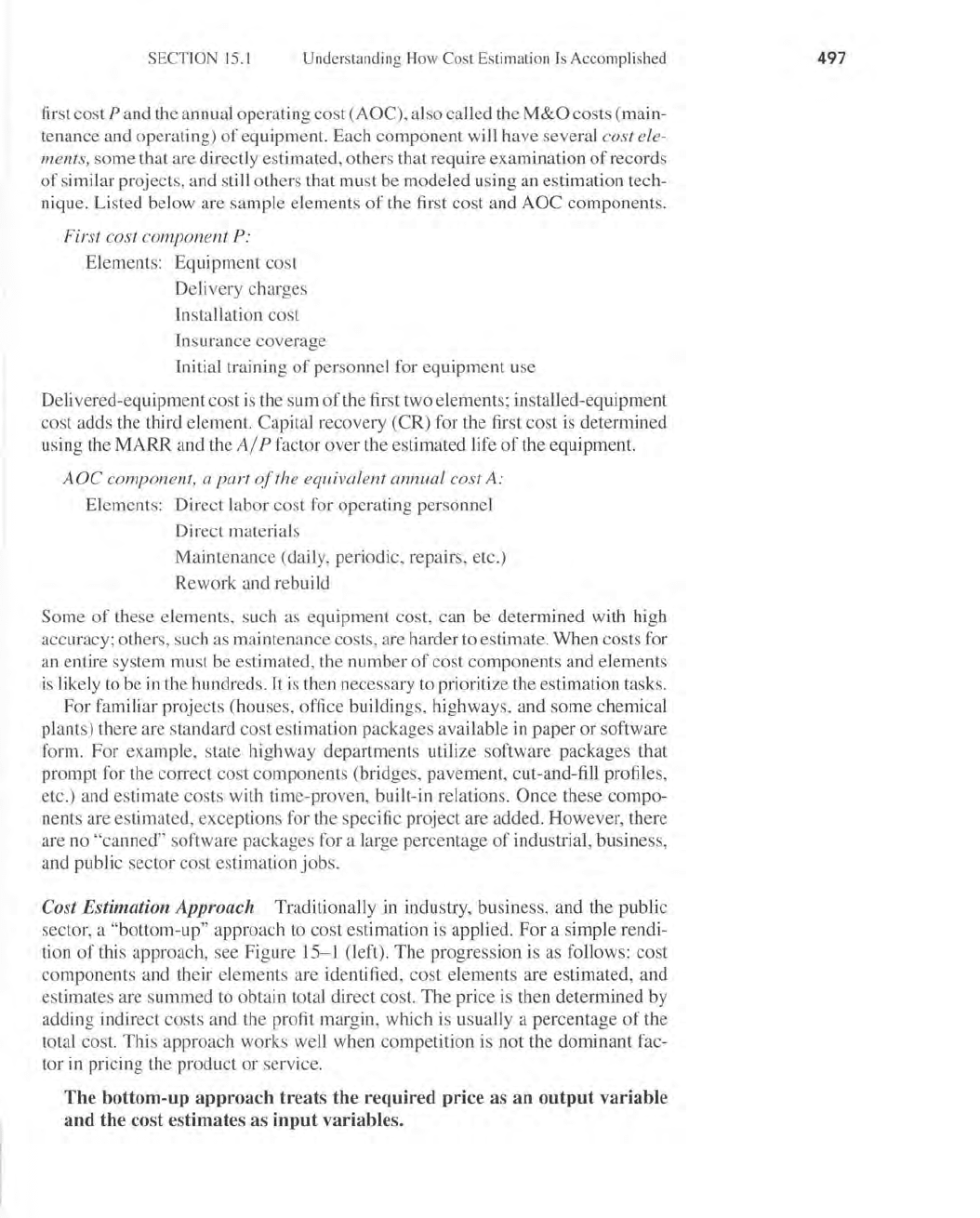
SECTION
15.1
Understanding How Cost Estimation Is Accomplished
first cost P and the annual operating cost (AOC), also
ca
lled the
M&O
costs (main-
tenance and operat
in
g)
of
equipment. Each
component
will have several cost ele-
ments, some that are directly estimated, others that require examination
of
records
of
similar projects, and sti
ll
others that must be modeled using an estimation tech-
nique. Listed below are sample elements
of
the first cost and AOC components.
First cost component
P:
Elements:
Equipment
cost
Del i very charges
Installation cost
Insurance coverage
Initial training
of
personnel for equipment use
Delivered-equipment cost
is
the sum
of
the first two elements; installed-equipment
cost adds the third element. Capital recovery (CR) for the first cost is determined
using the
MARR
and the
AI
P factor over the estimated life
of
the equipment.
AOe
component, a part
of
the equivalent annual cost
A:
Elements: Direct labor cost for operating personnel
Direct materials
Maintenance (daily, periodic, repairs, etc.)
Rework and rebuild
Some
of
these elements, such as equipment cost, can be determined with high
accuracy; others, such as maintenance costs, are harder to estimate. When costs for
an entire system must be estimated, the number
of
cost components and elements
is likely to be
in
the hundreds.
It
is then necessary to prioritize the estimation tasks.
For familiar projects (houses, office buildings, highways, and some chemical
plants) there are standard cost estimation packages available
in
paper or software
form. For example, state highway departments utilize software packages that
prompt for the correct
cost
components (bridges, pavement, cut-and-fill profiles,
etc.) and estimate costs with time-proven, built-in relations. Once these compo-
nents are estimated, exceptions for the specific project are added. However, there
are no "canned" software packages for a large percentage
of
industrial, business,
and public sector cost estimation jobs.
Cost Estimation Approach Traditionally
in
industry, business, and the public
sector, a "bottom-up" approach to cost estimation is applied.
For
a simple rendi-
tion
of
this approach, see Figure 15-1 (left).
The
progression
is
as follows: cost
components and their elements are identified, cost elements are estimated, and
estimates are summed to obtain total direct cost.
The
price
is
then determined by
adding indirect costs and the profit margin, which is usually a percentage
of
the
total cost. This approach works we
ll
when competition
is
not the dominant fac-
tor
in
pricing the product
or
service.
The
bottom-up
approach
treats
the
required
price
as
an
output
variable
and
the
cost
estimates
as
input
variables.
497

498
Figure 15-1
Simplified cost estimation
processes for bottom-
up
and top-down
approaches.
CHAPTER 15 Cost Estimation and Indirect Cost Allocation
Top-down approach
Require
d_
•
•
_ Competitive
pnce
i
~
price
Desired
+
-
A
ll
owed
profit
profit
Total cost
=
=
Target cost
In
direct
+it
it+
Indirect
costs
costs
Direct
~
costs
Maintenance
+t
t+
Maintenance
and operations a
nd
opera
ti
ons
Direct
+t
t+
Direct
labor
labor
Cost
Cost
compone
nt
t t
compone
nt
estimates
Direct
estimates
Direct
+ +
mate
ri
als
materials
Equipment a
nd
capital recove
ry
+
~ ~
+
Equipment
cap
it
al recove
ry
At design stage
Before design stage
Bo
tt
om-up approach
Design-to-cost approach
Figure
15
- 1 (above) shows a simplistic progression for the design-to-cost, or
top-down, approach. The competitive price establishes the target cost.
The
design-to-cost,
or
top-down,
approach
treats the competitive price as
an
input
variable
and
the cost estimates as
output
variables.
This approach places greater emphasis on the accuracy
of
the price estimation
activity. The target cost
mu
st be rea
li
stic, or it can be a disincentive
to
design and
engineering staff.
The design-to-cost approach is best applied in the early stages
of
a new or en-
hanced product design. The detailed design and specific equipment options are
not yet known, but the price estimates assist in establishing target costs for
di
f-
ferent components. This approach
is
useful in encouraging innovation, new de-
sign, manufacturing process improvement, and efficiency. These are some
of
the
essentials
of
va
lue engineering and value-add
ed
systems engineering.
Usually, the resulting approach is some combination
of
these two cost estima-
tion philosophies. However, it is helpful
to
understand up front what approach is
to
be emphasized. Historically, the bottom-up approach is more predominant
in
Western engineering cultures, especially in the United States and Canada. The
design-to-cost approach is considered routine in Eastern engineering cultures,
especia
ll
y
in
industria
li
zed nations such
as
Japan and other Asian countries.

SECTION 15.2 Cost Indexes
Accuracy
oj
the Estimates No cost estimates are expected to be exact; how-
ever, they are expected to be reasonable and accurate enough to support eco-
nomic scrutiny.
The
accuracy required increases as the project progresses from
preliminary design to detailed design and on to
economic
evaluation. Cost esti-
mates made before and during the preliminary design stage are expected to be
good "first-cut" esti
mates
that serve as input to the project budget. Estimation
techniques, such as the unit method, are applicable at this stage.
The
unit method
is
a popular, very pre]jminary estimation technique.
The
total
estimated cost
is
obtained by multiplying the number
of
units by a per unit cost
factor. Sample cost factors are
Cost
of
automobile operation per mile, including fuel, insurance, wear and
tear (e.g., 34.5 cents per mile)
Cost
of
house construction per livable square foot (e.g.,
$150
per square foot)
Cost
of
buried electrical cable per mile
Cost per parking space in a parking garage
Cost
of
constructing a standard-width suburban street
per
mile
Instances
of
the unit method are evident
in
everyday business activities.
If
house
construction costs average
$150
per square foot, a pre]jminary
cost
estimate for
a 2000-square-foot
home
is $300,000.
If
car
travel is expensed at $0.345 per
mile, a 200-mile business trip should cost approximately
$70
for the car.
When utilized at early and conceptual design stages, the estimates above are
often referred to as order-oJ-magni tude estimates. At the detai led design stage, cost
estimates are expected to be accurate enough to support economic evaluation for a
go-no go decision. Every project setting has its own characteristics, but a range on
estimates
of
::!:::5%
to::!:::
15%
of
actual costs
is
expected at the detailed design stage.
Cost Estimation Techniques
Methods
such as expert opinion and comparison
with comparable installations serve as excellent estimators.
The
use
of
cost in-
dexes bases the present
cost
estimate on past cost experiences, with inflation
considered. Models such as cost-capacity equations and the Jactor method are
simple mathematical techniques applied at the preliminary design stage.
These
cost-estimating relationships (eER) are presented in the following sections.
There are many additional methods discussed
in
the handbooks and pub]jcations
of
different industry and business sectors.
15.2
COST INDEXES
A cost index
is
a ratio
of
the cost
of
something today to its cost sometime in the past.
As such, the index
is
a dimensionless number that shows the relative cost change
over time.
One
such index that most people are familiar with is the Consumer Price
Index (CPI), which shows the relationship between present and past costs for many
of
the things that "typical" consumers must buy. This index includes such items as
rent, food, transportation, and certain services.
Other indexes track the costs
of
equipment, and goods and services that are more pertinent to the engineering dis-
ciplines. Table 15-1
is
a listing
of
some
of
the more common indexes.
499
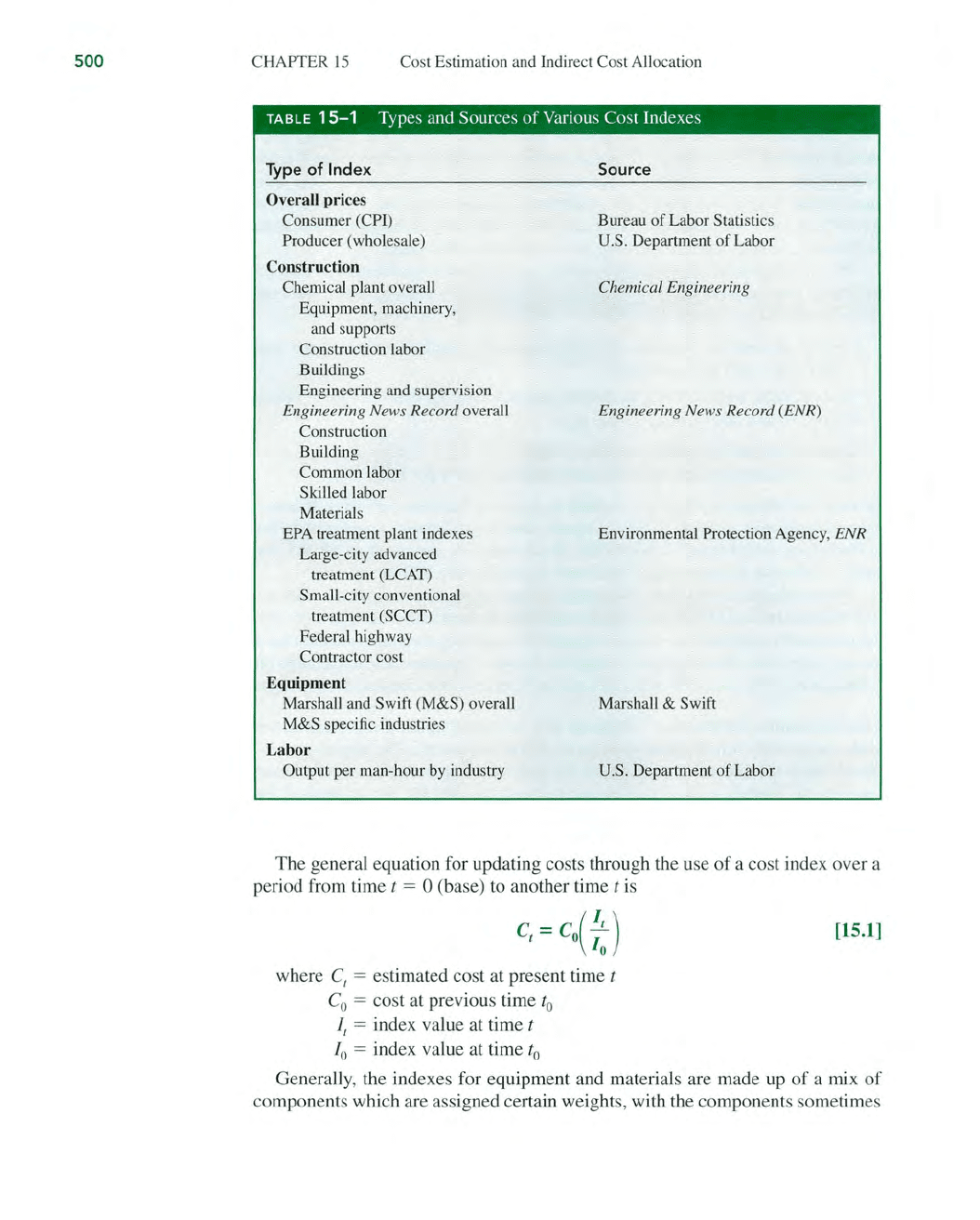
500
CHAPTER
15
Cost Estimation and Indirect Cost Allocation
TABLE
15-1
Types and Sources
of
Various Cost Indexes
Type of Index
Overa
ll
prices
Consumer (CPI)
Producer (wholesale)
Construction
Chemical plant overall
Equipment, machinery,
and supports
Construction labor
Buildings
Engineering and supervision
Engineering News Record overall
Construction
Building
Common labor
Skilled labor
Materials
Source
Bureau
of
Labor Statistics
U.S. Department
of
Labor
Chemical Engineering
Engineering News Record (ENR)
EPA treatment plant indexes
Large-city advanced
treatment (LCAT)
Small-city conventional
treatment
(SCCT)
Federal highway
Contractor cost
Environmental Protection Agency, ENR
Eq
ui
pment
Marshall and Swift (M&S) overall
M&S specific industries
Labor
Output per man-hour by industry
Marshall &
Swift
U.S.
Department
of
Labor
The general equation for updating costs through the use
of
a cost index over a
period from time
t = 0 (base) to another time
tis
C = C
(~)
t 0 I
o
[15.1]
where C, = estimated cost at present time t
Co = cost at previous time
to
I, = index value at time t
10
= index value at time
to
Generally, the indexes for equipment and materials are made up
of
a mix
of
components which are assigned certain weights, with the components sometimes
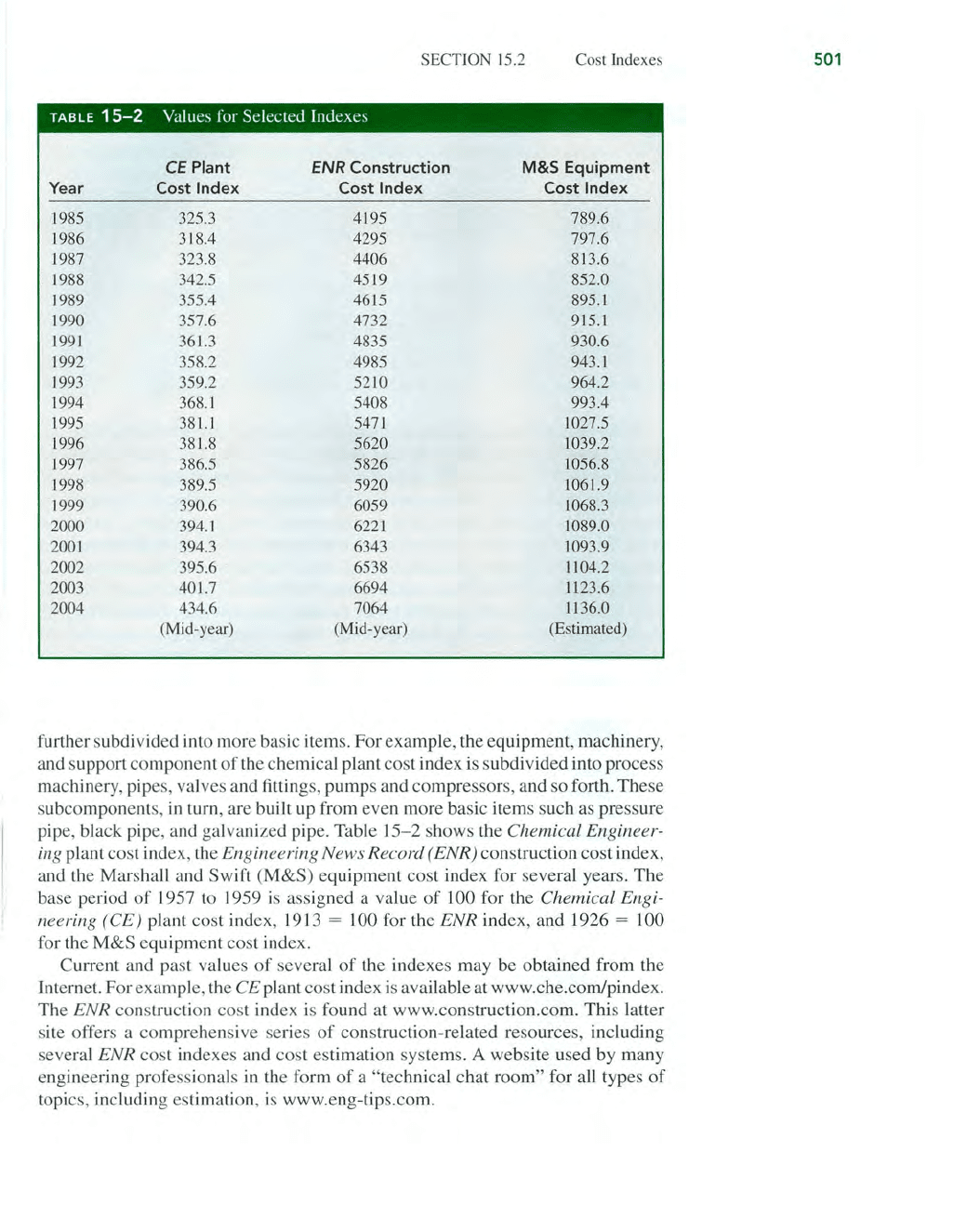
SECTION
15
.2
Cost I
nd
exes
TABLE
15-2
Va
lu
es
fo
r Selected Indexes
CE
Plant
ENR
Construction
M&S
Equi
pment
Year Cost Index Cost Index Cost Index
1985
325.3 41
95
789.6
1986 318.4 4295 797.6
1987 323.8 4406
813.6
1988
342.5 4519 852.0
1989
355.4 4615 895.1
1990
357.6 4732 915.1
1991
361
.3
4835 930.6
199
2 358.2 4985 943.1
J993 359.2 5210
964.2
1994 368.1 5408
993.4
1995 381.l 5471
1027.5
1996 381.8
5620 1039.2
1997 386.5
5826 1056.8
J998 389.5
5920 106
1.
9
1999
390.6
6059
1068.3
2000 394.1 6221 1089.0
2001 394.3 6343 1093.9
2002 395.6 6538
1104.2
2003
40
1.
7 6694
1123.6
2004 434.6 7064
1136.0
(Mid-year) (Mid-year)
(Estimated)
further subdi vided into more basic item
s.
For
example, the equipment, machinery,
and support
co
mponent
ofthe
chemical plant
cost
index is subdi vided into process
machinery, pipes, va
lv
es and fittings,
pump
s and compressors, and so forth.
The
se
sub
co
mponents,
in
turn, are built up from even more basic items such as pressure
pipe, black pipe, and galvanized pipe. Table
15-2
shows the Chemical Engineer-
ing
plant
cost
index, the Engineering News Record (ENR) construction cost index,
and
th
e Marshall and Swift (M&S)
equipment
cost index for several year
s.
The
base period
of
1957 to 1959 is assigned a value
of
100 for the Chemical Engi-
neering (CE)
plant cost index, 1913 = 100 for the
ENR
index, and 1926 = 100
for the
M&S
equipment cost index.
Current and past values
of
several
of
the indexes
may
be
obta
ined from the
Internet.
For
example, the
CE
plant cost index is available at www.che.comJpindex.
The
EN
R
co
nstru
ct
ion cost index is found at
www.construction.com.This
latt
er
site offers a
co
mprehensive series
of
construction-related resources, including
several
ENR
cost indexes and cost estimation system
s.
A website used by many
en
gi
n
ee
ring professionals in the form
of
a "technical
chat
room" for all types
of
topics, including estimation, is www.eng-tips.com.
501
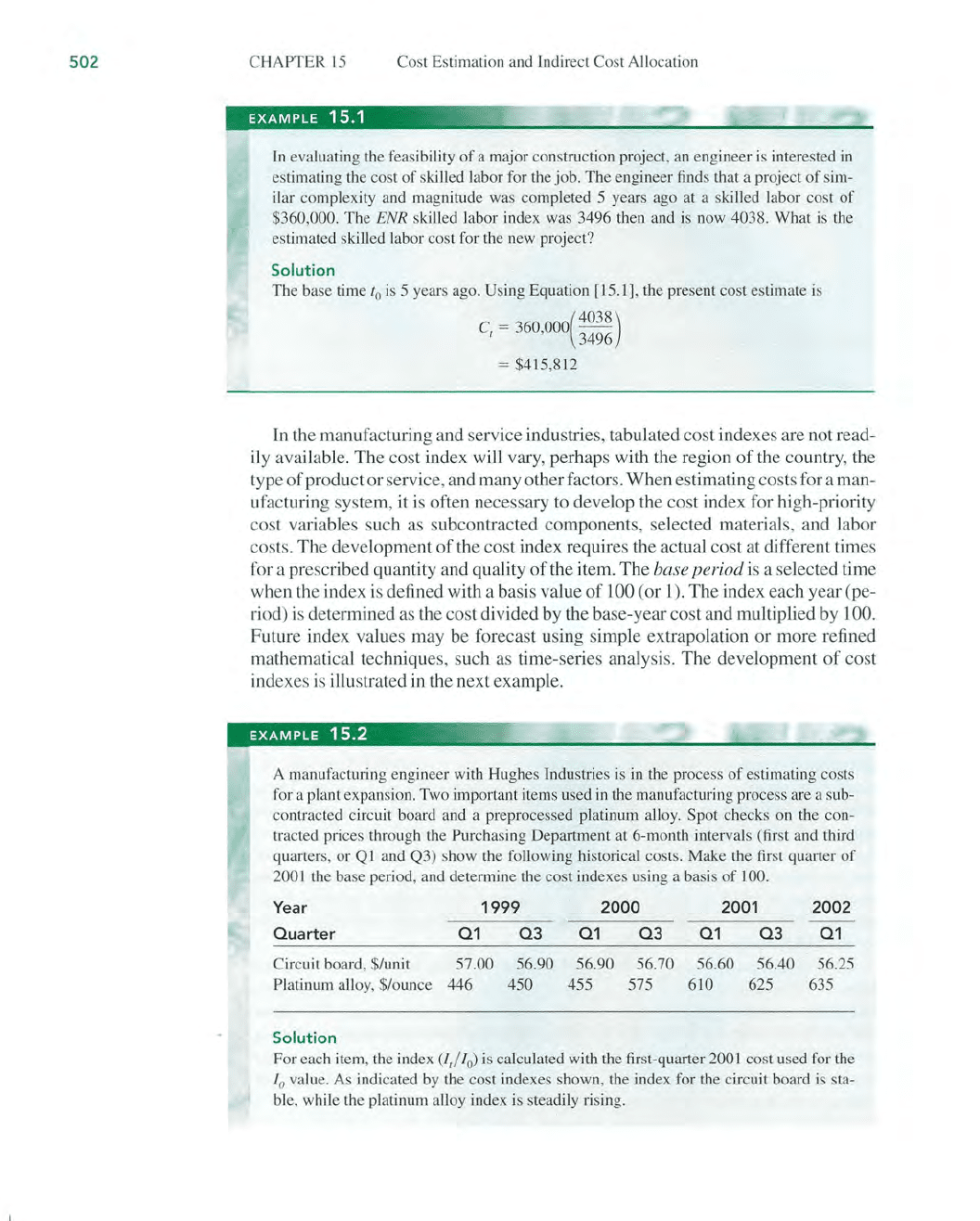
502
CHAPTER
15
Cost Estimation and Indirect Cost Allocation
In
eva
lu
ating the feasibility
of
a major construction project, an engineer
is
interested
in
estimating the cost
of
skilled labor for the job.
The
engineer finds that a project
of
sim-
ilar complexity and magnitude was completed 5 years ago at a skilled labor cost
of
$360,000.
The
ENR
skilled labor index was 3496 then and
is
now 4038. What
is
the
estimated skilled labor cost for the new project?
Solution
The
base time 10
is
5 years ago. Using Equation [J5.1], the present cost estimate is
C
=
360000(4038)
f ' 3496
= $415,812
In the manufacturing and service industries, tabulated cost indexes are not read-
ily available. The cost index will vary, perhaps with the region
of
the country, the
type
of
product
or
serv
ic
e, and many other factors.
When
estimating costs for a man-
ufacturing system, it is often necessary to develop the cost index for high-priority
cost variables such as subcontracted components, selected materials, and labor
costs.
The
development
of
the cost index requires the actual cost at different
ti
mes
for a prescribed quantity and quality
of
the item. The base period is a selected time
when the index
is
defined with a basis value
of
100 (or 1
).
The
index each year (pe-
riod)
is
determjned as the cost divided by the base-year cost and multiplied by 100.
Future index values may be forecast using simple extrapolation
or
more refined
mathematical techniques, such as time-series analysis. The development
of
cost
indexes
is
illustrated in the next example.
EXAMPLE
15.2
'-.
A manufacturing engineer with Hughes Industries
is
in the process
of
estimating costs
for a plant expansion. Two important items used
in
the manufacturing process are a sub-
contracted circuit board and a preprocessed platinum alloy. Spot checks on the co
n-
tracted prices through the Purchasing Department at 6-month intervals (first and third
quarters, or Q
I and Q3) show the following historical costs. Make the first quarter
of
2001 the base period, and determine the cost indexes us
in
g a basis
of
100.
Year 1999 2000 2001 2002
Ouarter
01
03
01
03
01
03
01
CiJ'cuit board, $/unit 57.00 56.90 56.90 56.70 56.60 56.40 56.25
Platinum alloy, $Iounce 446 450 455 575 610 625 635
Solution
For each item, the index
(1
,/
/
0
)
is
calc
ul
ated with the first-quarter
200
1 cost used for the
10 value. As indicated by the cost indexes shown, the index for the circuit board is sta-
ble, while the platinum a
ll
oy index is steadily
ri
sing.
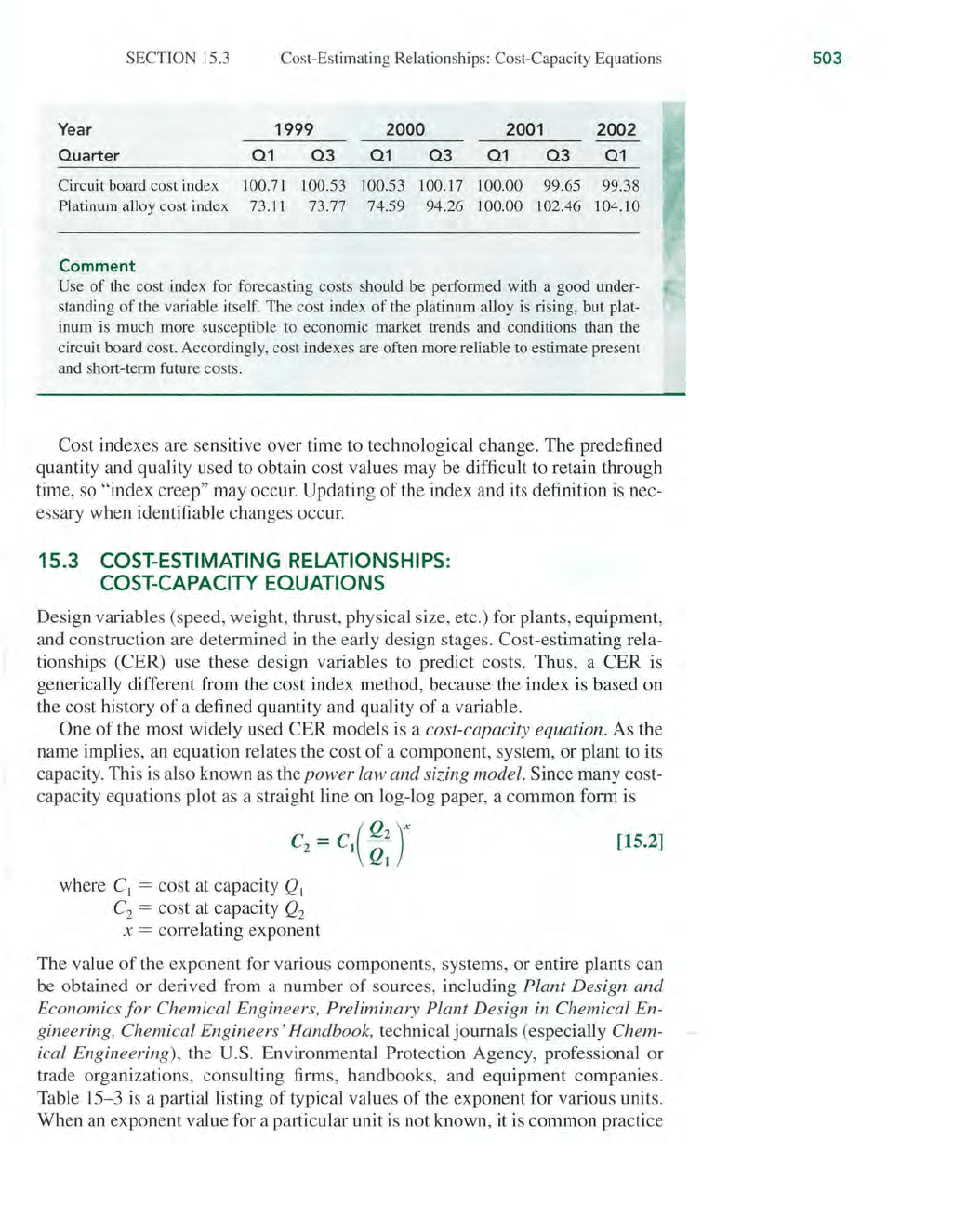
SECTION
15
.3 Cost-Estimating Relationships: Cost-Capacity Equations
Year
Quarter
Q1
1999
Q3
2000
Q1
2001
Q3
Q1
Q3
2002
Q1
Circuit board cost i.ndex
Platin
um
a
ll
oy cost index
100.71 100.53 100.53 100.17 100.00 99.
65
99.38
73.11 73.77 74.59 94.26
100.00 102.46 104.10
Comment
Use
of
the cost index for forecasting costs sho
ul
d be performed with a good under-
standing
of
the vari
ab
le itself. The cost index
of
the platinum a
ll
oy
is
rising, but plat-
inum
is
much more susceptible to economic market trends and conditions than the
circuit board cost. Accordingly, cost indexes are often more reliable to estimate present
and short-term future costs.
Cost indexes are sensitive over time to technological change. The predefined
quantity and quality used to obtain cost values may be difficult to retain through
time, so
"index creep" may occur. Updating
of
the index and its definition
is
nec-
essary when identifiable changes occur.
15.3
COST-ESTIMATING RELATIONSHIPS:
COST-CAPACITY EQUATIONS
Design variables (speed, weight, thrust, physical size, etc.) for plants, equipment,
and construction are determined
in
the early design stages. Cost-estimating rela-
tionships (CER) use these design variables to predict costs. Thus, a
CE
R is
generically different from the cost index method, because the index
is
based on
the cost history
of
a defined quantity and quality
of
a variable.
One
of
the most widely used
CER
models
is
a cost-capacity equation. As the
name implies, an equation relates the cost
of
a component, system, or plant to its
capacity. This is also known as the
power law and sizing model. Since many cost-
capacity equations plot as a straight line on log-log paper, a common form
is
where
C\
= cost at capacity Q\
C
2
= cost at capacity Q
2
x = correlating exponent
[15.2]
The value
of
the exponent for various components, systems, or entire plants can
be obtained or derived from a number
of
SOUfces,
including Plant Design and
Economics for Chemical Engineers, Preliminary
Plant Design in Chemical En-
gineering,
Ch
emical Engineers' Handbook, technicaljoumals (especially
Ch
em-
ical Engineering),
the U.S. Environmental Protection Agency, professional or
trade organization
s,
consulting firms, handbooks, and equipment companies.
Table
15-3
is
a partial listing
of
typical values
of
the exponent
fOf
various units.
When an exponent value for a partic
ul
ar unit is not known, it
is
common practice
503
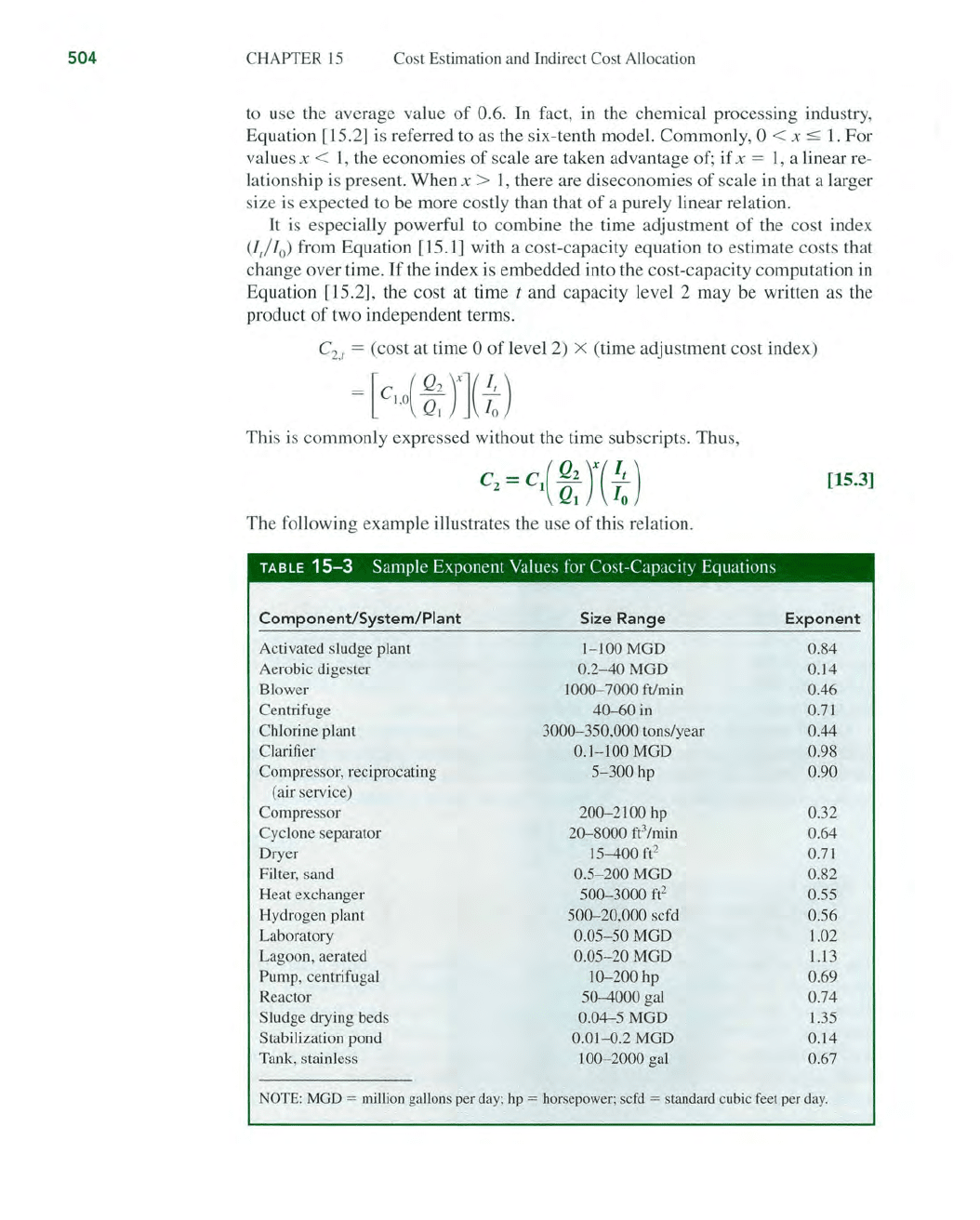
504
CHAPTER
15
Cost
Estimation and Indirect Cost Allocation
to use the average value
of
0.6. In fact,
in
the chemical processing industry,
Equation [15.2] is refelTed to as the six-tenth model. Commonly,
0 <
x:::;
1.
For
values
x <
1,
the economies
of
scale are taken advantage of; if x =
1,
a linear re-
lationship
is
present. When x >
1,
there are diseconomies
of
scale
in
that a larger
size is expected to be more costly than that
of
a purely linear relation.
It
is especially powerful to combine the time adjustment
of
the cost index
(1
,/
1
0
)
from Equation [15.1] with a cost-capacity equation to estimate costs that
change over time.
If
the index is embedded into the cost-capacity computation
in
Equation [15.2], the cost at time t and capacity level 2 may be written as the
product
of
two independent terms.
C
2.t
= (cost at time 0
of
level 2) X (time adjustment cost index)
This
is
commonly expressed without the time subscripts. Thus,
[15.3]
The following example illustrates the use
of
this relation.
TABLE
15-3
Sample Exponent
Va
lu
es for Cost-Capacity E
qu
at
ions
C
omponent/S
y
stem/
Plant Size R
ange
Ex
pon
ent
Activated sludge
plant
l-lOOMGD
0.84
Aerobic digester
0.2-40MGD
0.14
Blower
1000-7000 ft/min 0.46
Centrifuge
40-60
in
0.71
Chlorine plant
3000-350,000
tons/year 0.44
Clarifier
0.1-100
MGD
0.98
Compressor, reciprocating
5-300
hp 0.90
(air service)
Compressor
200-2100
hp 0.32
Cyclone separator
20-8000
fe/min
0.64
Dryer
15-400
ft
2
0.71
Filter, sand 0.
5-200MGD
0.82
Heat
exchanger
500-3000
ft
2
0.55
Hydrogen plant
500-20,000
scfd
0.56
Laboratory
0.05-50MGD
1.02
Lagoon, aerated
0.05-20MGD
1.13
Pump
, centrifugal
10-200
hp
0.69
Reactor
50-4000
gal 0.74
Sludge drying beds
0.04-5MGD
1.35
Stabilization pond
0.01-0.2
MGD
0.14
Tank, stainless JOO-2000 gal 0.67
NOTE: MGD = million gallons per day; hp = horsepower; scfd = standard cubic feet per day.
